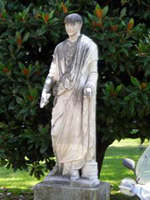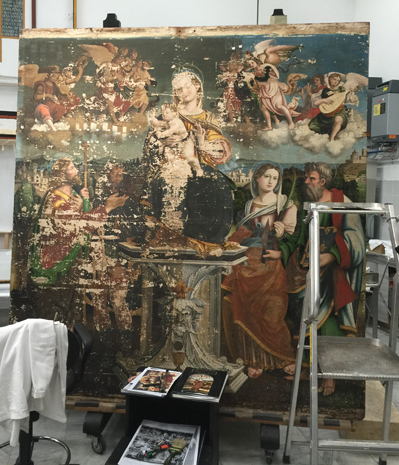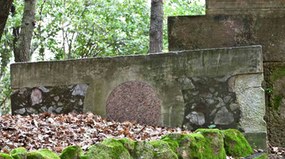ART: Bacteria at work to restore statues and fountains in Vatican Gardens
25/5/2015
Restoring artworks using bacteria and natural substances in place of potentially harmful chemicals may prove more effective.
“Bio-restoration” is an Italian made technology developed at ENEA, to be used soon in the revamping of the statues and fountains in the Vatican Gardens.
 Bio-restoration is a bio-based method employing microorganisms to clean up works of art by removing unwanted deposits, presenting many advantages due do its characteristics of high selectivity, low aggression towards artworks, non-toxicity for restorers, low implementation cost and environmental compatibility.
Bio-restoration is a bio-based method employing microorganisms to clean up works of art by removing unwanted deposits, presenting many advantages due do its characteristics of high selectivity, low aggression towards artworks, non-toxicity for restorers, low implementation cost and environmental compatibility.
The use of biotechnologies - already utilized for soil remediation - for the restoration of artworks was discussed at the recently held workshop “Bio-based technologies and products for sustainable strategies for the conservation of Cultural Heritage and soil remediation” organized by ENEA with the participation of representatives of the Cultural Heritage sector including Ulderico Santamaria, Director of the Cabinet of Scientific Research of the Vatican Museums and Giuseppina Fazio, of the Higher Institute for Conservation and Restoration of Historic and Artistic Works.
“Scientific research has found in microorganisms a formidable ally in the preservation and conservation of artwork. We have found a way to turn a problem into a resource by exploiting the metabolic activity of microorganisms living in archaeological sites in a state of decay, using them to restore the very artwork in need of restoration” Anna Rosa Sprocati, Coordinator of the “Environmental Microbiology and Microbial Biotechnologies” Laboratory at ENEA explains.
 Research staff at the laboratory includes Chiara Alisi, Flavia Tasso, Paola Marconi, Giada Migliore and several PhD and graduate students who have contributed to the research over the years.
Research staff at the laboratory includes Chiara Alisi, Flavia Tasso, Paola Marconi, Giada Migliore and several PhD and graduate students who have contributed to the research over the years.
Bacteria and fungi, transported to the laboratory and isolated, are successively used in restoration interventions. To date, ENEA has selected 500 bacterial and fungal strains, an actual army of potential “micro–repairers” performing “customized” interventions according to the material to be restored (paintings, frescoes, paper, parchment, marble or wood) and the deposit to be removed (animal or chemical glues, resins, hydrocarbons, oils, chalk or carbonates).
As of today, the results obtained have been more than satisfactory and the researchers consider bio-restoration a viable alternative to more aggressive conventional methods.
Amongst ENEA's interventions there have been a restoration treatment on the Palace of the Popes in Avignon, using a laboratory - developed method for the removal of vinyl glues from frescoes, and a biocleaning intervention on part of the Loggia at the Renaissance Casina Farnese on the Palatine Hill, illustrating the myth of Hercules and Cacus, utilizing a laboratory - developed method for which ENEA has been granted both a European and an International patent. (ENEA Patent on Bio-restoration, European Patent Office Database).
ENEA has had many collaborations, from the Higher Institute for Conservation and Restoration of Artistic Works, to the Vatican Museums to the National Gallery of Modern Art, where two marble sculptures were displayed, ”Testa di Donna” by Emilio Quadrelli and “Lupa” by Giuseppe Graziosi, the latter exposed to an external environment for 40 years, on which ENEA researchers performed, jointly with restorers, a biocleaning intervention to remove wax and smog deposits.
 It was a short step from environmental bioremediation to biotechnologies for the restoration and conservation of artworks. The mixture of microorganisms used in the biocleaning intervention on the “Lupa”, had already proved effective in the reclamation of an hydrocarbon contaminated site.
It was a short step from environmental bioremediation to biotechnologies for the restoration and conservation of artworks. The mixture of microorganisms used in the biocleaning intervention on the “Lupa”, had already proved effective in the reclamation of an hydrocarbon contaminated site.
Currently Bioremediation is the only technology allowing transformation of contaminants without affecting soil fertility and functions.
For more information please contact:
Anna Rosa Sprocati, “Environmental Microbiology and Microbial Biotecnologies” ENEA Casaccia Research Center, annarosa.sprocati@enea.it
